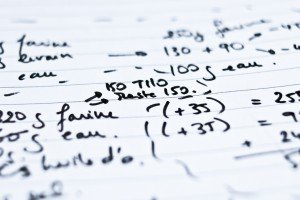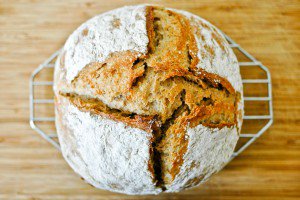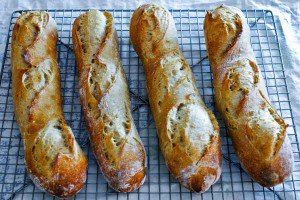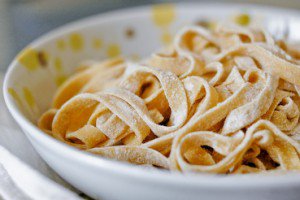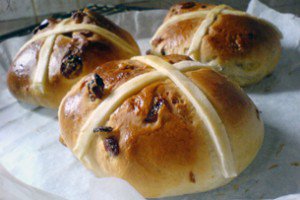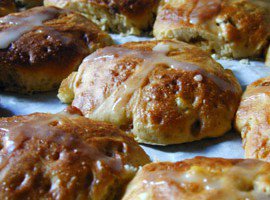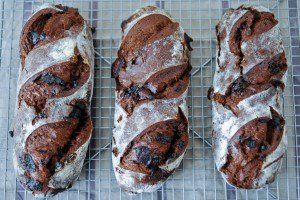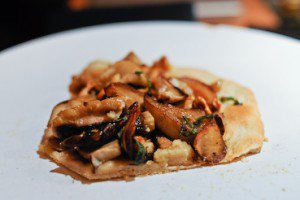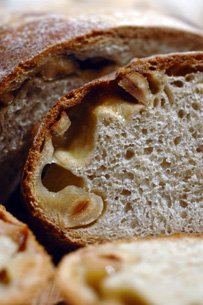
[Bread Baking Class]
Hi, my name is Clotilde, and I have conquered my fear of yeast.
For years and years, everytime a recipe called for yeast — dry, instant, fresh, whatever — I would write it off with a resigned sigh, like the plain teenaged girl writes off the popular unkempt boy, thinking, “He’s not for me.”
I didn’t know the moves, I didn’t know where to begin, I didn’t know how things worked, I didn’t know what the dough should look and feel like, and it all felt very mysterious and very intimidating. I had bought a blindingly handsome stand mixer to encourage myself, and while the leaf and whisk attachments were frequently taken for a spin, the dough hook remained in the cabinet, sulking what it thought to be a guilt-inducing sulk, and rightly so.
But then one morning I looked at myself in the bathroom mirror and said to myself, “You’re twenty-seven now. Shouldn’t you take the bull by the horns and just take a friggin’ bread-baking class?” And with that, I went online and booked myself one.
The class was held on a Saturday afternoon at the back of a bakery in the 20th called Le 140, whose baguette once won the much-coveted Meilleure Baguette de Paris prize. Our teacher was Jean-Michel, a friendly and energetic boulanger who made the class as fun as it was instructive.
When we arrived, everything had been pre-measured* for the frasage, the step that consists in pouring water into the bowl of flour, salt, and yeast, and then blending everything together with your hand until the dough stops sticking to the sides of the bowl and your hand looks like it’s wearing a cement glove.
[Notes and tips: Use only one of your hands for the frasage so you can still use the other one to hold the bowl, and rub your nose when it unavoidably itches. We used the yeast directly, without diluting it first as some recipes instruct you to. The salt and yeast were placed on the flour well apart from one another so they wouldn’t touch, otherwise the power of the yeast would be lessened.]
We turned the dough out on the lightly floured work surface and started kneading, pushing a small part of the dough firmly away from us with one hand and pulling it all the way back over the dough, before giving the dough an eighth of a turn and repeating this step. We kneaded and kneaded until the dough was smooth and slightly warm and we couldn’t feel our shoulders anymore .
We then divided the dough into four pieces, which allowed us to make all sorts of clever jokes about the biblical arithmetics of bread. Each piece was shaped according to the type of loaf it was destined to be. One of them was stuffed with diced comté cheese and chopped walnuts, and for this we folded the dough over the ingredients once and over itself multiple times, so the ingredients would be distributed evenly. All the pieces were covered with cloth for the first rise, a.k.a. le pointage, which lasted 30 minutes.
In the meantime, we were given a little tour of the bakery and were thus introduced to the mechanical pétrin, the dividing machine, the cold chambers where they keep the loaves in preparation for the morning, and the bakery’s ten-year-old starter.
When we came back, our loaves had risen, and it was time for the final shaping — le façonnage. We prepared one ball-shaped cheese and nut loaf, one bâtard (a squat, oval loaf), one small baguette on which we wrote stuff**, and one long baguette that was sprayed with water and dipped in sesame. The loaves were then placed seam-side down on racks, and our teacher was very careful to put the loaves in the right order so each apprentice-baker would go home with his own. The loaves were then left to rise for another 45 minutes, a step called l’apprêt.
In the meantime, we were offered a little bread tasting to keep us busy and happy. When the loaves had risen, we floured and slashed the tops of the bâtards with a razor blade, cut ears with scissors in the sesame baguettes, and Jean-Michel slipped all the loaves into the oven with the handy conveyor belt.
Some thirty minutes later, his wooden paddle excavated our perfectly golden, perfectly fragrant creations, which were taken home and shared with the suitably impressed friends who happened to come for the apéro that evening.
A few days later, while the process was still fresh in my hands’ memory, I tried to reproduce it in my own kitchen. I used a bit less yeast this time, and a mix of flours — white, organic bise, and buckwheat***. I baked one Abondance cheese and hazelnut loaf (pictured above), one loaf stuffed with a mix of dried fruits and almonds (lovely for breakfast), and one bâtard (I tried to slash it with a knife, but a clean Stanley knife, simply called un cutter in French, would give neater results). The last quarter was kept in the fridge after the first rise and used the next day as a fantastic pizza dough.
All went smoothly: since it wasn’t very warm in my apartment I left the dough to rise in my oven at minimum temp, the loaves were baked at 250°C (480°F) with a cup of water placed on the rack to keep the air humid, and although the crusts weren’t as light and crisp as those a professional oven would create, my production was certainly nothing to be ashamed of.
And now that I’m feeling all extatic and confident in my newfound yeast-wisdom, I have to try my hand at the current craze of the bread-making world, Jim Lahey’s no-knead bread, which Donna’s husband and Rainey have already tried and loved — stay tuned.
* The recipe we used was: 700 grams flour (the French T55 grade, which is equivalent to the American all-purpose flour), 17 grams fresh yeast, 17 grams salt, and 420 grams cold water. For home use, and when one is not limited to the duration of the class, Jean-Michel recommended using 12 grams of yeast, and making the second rise last an hour and a half.
** Pâte à écriture [writing paste]: 1 teaspoon unsweetened cocoa powder, 1 teaspoon flour, 1/2 egg white. Blend everything together, spoon into a quickly-assembled paper cone, snip the end of the cone to form a tiny opening, and pipe onto the bread just before the second rise.
*** I used: 400 grams all-purpose/T55 flour, 225 grams light brown/bise/T60 flour, and 75 grams buckwheat flour, 12 grams fresh yeast, 17 grams salt, and 420 grams cold water. The second rise went on for an hour and a half.


